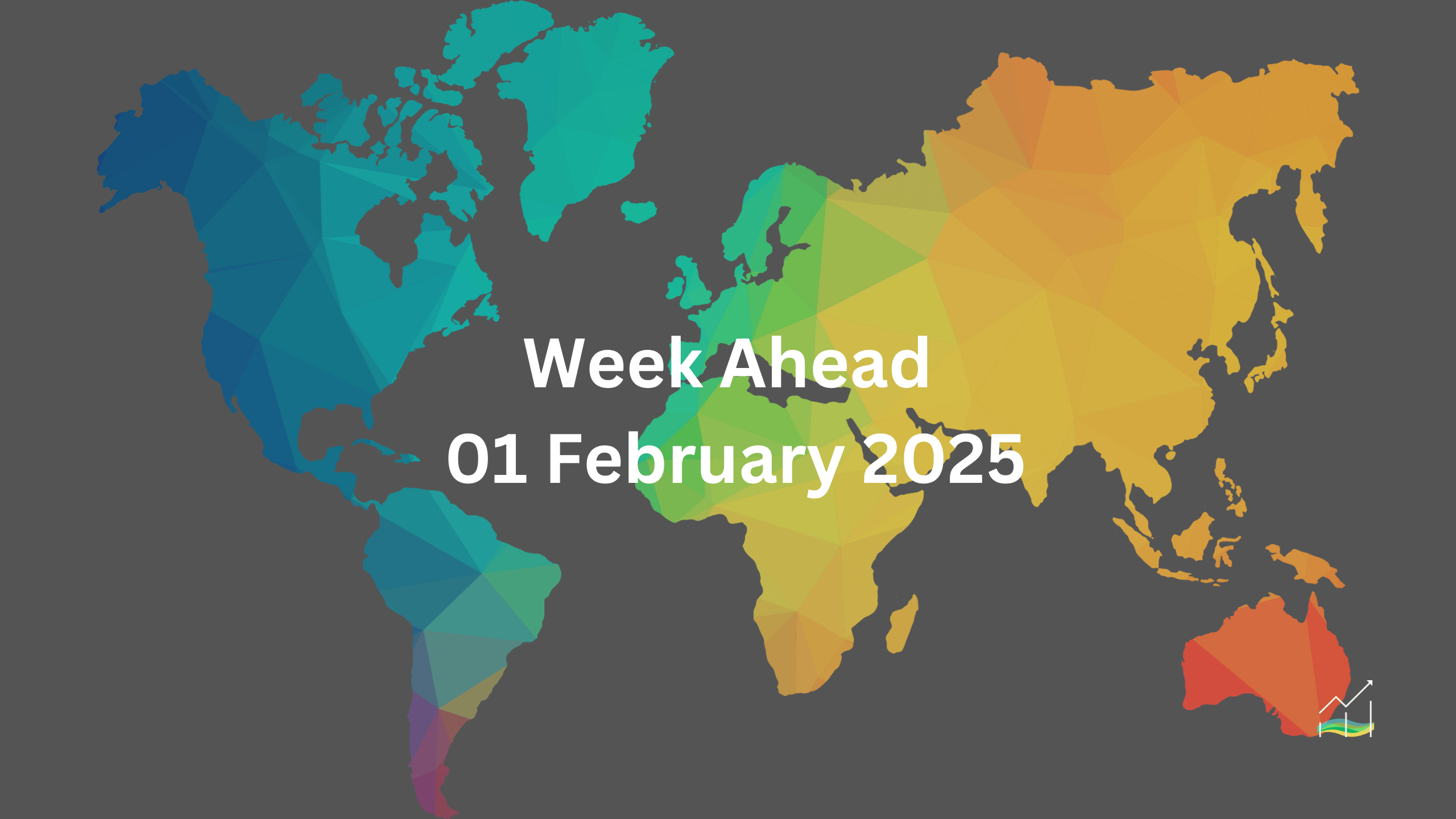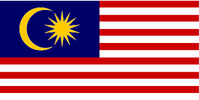01/02/2025 Week Ahead

The Global Order is Shifting
Uncertainty dominates the economic and geopolitical landscape, shaping investor sentiment and policy decisions. The unclear scope and timing of U.S. tariffs add to the unpredictability, while China’s unveiling of DeepSeek challenges the effectiveness of Western technology restrictions. Meanwhile, global conflicts persist, but a new phase of U.S. diplomacy is emerging.
The post-WWII era was defined by a global economic system rooted in free trade and multilateral cooperation. The U.S. played a leading role in shaping this order, expanding the “Open Door” policy and reinforcing institutions like the IMF and World Bank. However, shifting economic and political conditions, exacerbated by the Great Financial Crisis and the pandemic, have weakened the consensus supporting globalization. Calls for another Bretton Woods framework lack the material foundation necessary to restore the old order.
The U.S. is now pivoting away from the Open Door approach, instead focusing on securing its own sphere of influence. This shift is reflected in growing economic nationalism, strategic realignments, and the prioritization of domestic industry through near-shoring and onshoring efforts. At the same time, the U.S. appears more willing to allow other major powers to establish their own spheres of influence, signaling potential geopolitical realignments.
These changes have significant implications for global markets. The U.S. dollar, which had been strengthening, saw a pullback ahead of the presidential inauguration. In the coming week, key economic data releases—including ISM manufacturing and services figures, as well as nonfarm payrolls—will shape market expectations. Investors will also closely monitor any new tariff announcements from the U.S. administration.
Elsewhere, the Bank of England is expected to cut rates, and eurozone inflation data will be released. In Asia, central bank insights and inflation reports will provide further guidance for investors navigating this evolving landscape. As global dynamics shift, businesses must prepare for heightened risks, regulatory complexity, and the need for resilient supply chain strategies.
United States of America
Overview
Uncertainty looms over the markets as the U.S. considers imposing new tariffs, a move that could drive the dollar higher. While tariffs are often seen as inflationary, they did not significantly impact inflation or the trade deficit in Trump’s first term. The proposed tariffs, however, could act as a tax that stifles economic growth. Meanwhile, the Federal Reserve has left rates unchanged, with markets pricing in fewer rate cuts this year.
Economic Drivers
Data and Events
Key economic data in the coming week will shape market sentiment:
- ISM Manufacturing (Monday) & ISM Services (Wednesday) – Indicators of economic activity.
- JOLTS Job Openings (Tuesday) & ADP Private Payrolls (Wednesday) – Leading indicators for labor market strength.
- Nonfarm Payrolls (Friday) – The most critical data point, providing insight into employment trends.
- University of Michigan Consumer Sentiment (Friday) – A measure of consumer confidence in February.
- Trade Balance (Wednesday) & Productivity Data (Thursday) – Additional insights into economic conditions.
Investors will also be closely monitoring Trump’s decisions on tariffs, particularly the potential 25% levies on Canadian and Mexican imports from February 1. Any retaliatory measures or new tariffs on China and Europe could further impact the outlook.
Price Action
The Dollar Index posted its first decline since September, pulling back after a strong rally. Despite the recent correction, downside momentum may be nearing exhaustion. The outcome of economic data releases and tariff decisions will likely determine the next move in the currency markets.
Key Points:
- U.S. tariffs could lift the dollar but may also slow growth.
- The Fed left rates on hold, with markets expecting two cuts in 2025.
- Strong economic data could delay rate cuts, while weak data could support easing.
- Nonfarm payrolls and ISM reports will be critical for market expectations.
- The dollar’s correction may be nearing an end, with key data and tariff decisions driving the next move.
Australia
Overview
The Australian dollar has been in a downtrend since late September, falling from nearly $0.6950 to approach critical support between $0.6000 and $0.6100 by mid-January. It has since rebounded, retracing nearly a quarter of its losses before stalling above $0.6300. The weaker-than-expected Q4 CPI data has cleared a significant hurdle for the Reserve Bank of Australia (RBA) to begin easing rates at its February 18 meeting. However, with core inflation still slightly above target, the central bank may delay its first rate cut.
Economic Drivers
Australia remains one of the last G10 economies yet to begin its rate-cutting cycle, with markets pricing in at least three cuts for 2025. While soft inflation data supports a policy shift, strong household spending—driven by low unemployment and previous tax cuts—could make the RBA hesitant. Additionally, Australia’s trade deficit with the U.S. makes it less vulnerable to broad-based U.S. tariffs, though some specific products could be impacted.
Data and Events
The upcoming December retail sales data (Monday) will be closely watched for signs of consumer strength. Strong sales figures could add to the RBA’s concerns about demand-driven inflation, potentially delaying a rate cut. However, if spending shows signs of cooling, it could reinforce the case for an earlier policy shift.
Price Action
The Australian dollar’s key technical support lies between $0.6000 and $0.6100. A break below this zone would expose the pandemic-era low near $0.5500. For now, resistance is seen slightly above $0.6300, where the recent rebound stalled. The next move will likely depend on RBA policy decisions and the strength of domestic data.
Key Points:
- The Australian dollar’s rebound stalled above $0.6300 after a multi-month downtrend.
- Softer Q4 CPI data supports an RBA rate cut, but strong consumer demand may delay the move.
- Markets expect at least three rate cuts in 2025, with the first potentially in February.
- December retail sales data will provide further insight into household spending trends.
- A break below $0.6000-$0.6100 would leave little support before $0.5500.
Canada
Overview
The Bank of Canada (BoC) delivered a 25-basis-point rate cut in late January, marking the end of a 200-basis-point easing cycle that began last June. The next policy meeting is on March 12, by which time more economic data will be available, and the potential for U.S. tariffs may become clearer. While another cut is unlikely under normal conditions, the imposition of 25% U.S. tariffs on Canadian imports would pose a significant economic risk that could force a policy response.
Economic Drivers
Canada’s economy faces two major uncertainties—monetary policy divergence with the U.S. and potential trade disruptions. The U.S.-Canada interest rate gap has widened, with the U.S. two-year yield premium reaching its highest level since the late 1990s. Additionally, political uncertainty remains as the Liberal Party leadership contest takes place on March 9, and questions persist over whether the party can maintain confidence in parliament. Any instability in leadership could further impact investor sentiment.
Data and Events
Key economic data releases this week include:
- December trade data (Wednesday) – Provides insight into Canada’s export performance amid growing trade tensions.
- January jobs report (Friday) – A crucial indicator of labor market strength and potential monetary policy direction.
If U.S. tariffs materialize, concerns over Canada’s economic resilience will intensify, potentially leading to further BoC rate cuts. The central bank has already warned that a U.S.-Canada trade conflict could deliver a severe economic shock.
Price Action
The Canadian dollar remains under pressure, with the USD/CAD exchange rate approaching multi-decade highs. The last significant peaks were seen in early 2016 and again during the early stages of the pandemic, just below 1.47. A break above this level could signal further weakness for the Canadian dollar.
Key Points:
- The BoC cut rates by 25 bps in January, concluding a 200-bps easing cycle.
- A further cut in March is unlikely unless U.S. tariffs trigger a major economic shock.
- The U.S.-Canada rate gap is at its widest since the late 1990s, pressuring the CAD.
- December trade data and the January jobs report will provide key insights.
- USD/CAD is nearing critical resistance levels, with 1.47 as a historical high.
China
Overview
The Chinese yuan weakened by 4.5% from late September to mid-January, initially raising concerns that Beijing might let the currency slide in response to U.S. tariff threats. However, the People’s Bank of China (PBOC) took a different approach, lowering the dollar’s reference rate from CNY7.19 at the end of 2024 to just below CNY7.17 by late January. This adjustment effectively reduced the yuan’s 2% cap and limited further depreciation.
Despite signs that China’s property market downturn is stabilizing, the broader economy remains uncertain. The CSI 300 index fell nearly 3% in January, erasing the small gains from late 2024.
Economic Drivers
China’s Q4 GDP data exceeded expectations, but concerns remain about economic momentum. The January composite PMI dropped 4% to 50.1, marking the largest decline since April 2023 and raising doubts about sustained recovery.
Meanwhile, Beijing continues rolling out targeted economic reforms, including the latest “cash-for-clunkers” auto trade-in program, aimed at stimulating consumer demand. However, the PBOC’s decision to suspend bond purchases while relying on reverse repurchase agreements for liquidity suggests a reluctance to let yields fall further.
Data and Events
With Lunar New Year celebrations ongoing, China faces a quiet economic calendar. The key releases this week include:
- Caixin Manufacturing PMI (Monday) – Has indicated sector growth for three consecutive months.
- Caixin Services PMI (Wednesday) – Has remained in expansion for two years.
Markets will closely watch these reports for confirmation of China’s economic resilience. Any signs of deterioration in activity could undermine confidence in the recent economic recovery.
Price Action
The yuan remains under pressure, though PBOC interventions have slowed its decline. The central bank’s policy actions signal an effort to maintain stability, preventing excessive depreciation while ensuring adequate liquidity.
Key Points:
- The yuan fell 4.5% since September but stabilized after PBOC intervention.
- Q4 GDP beat expectations, but January PMI data raised concerns.
- Beijing introduced new economic stimulus measures, including auto trade-in subsidies.
- CSI 300 lost nearly 3% in January, despite prior gains.
- This week’s Caixin PMI data will be crucial in assessing economic stability.
Europe
Overview
The euro’s decline that started in late September, following the Federal Reserve’s 50 bp rate cut, extended into early January, reaching a low near $1.0180—its weakest level since November 2022. However, it staged a strong rebound before facing resistance in the $1.0560-75 range. Despite this recovery, the euro remains vulnerable, with markets pricing in another 50 bp of ECB rate cuts by mid-year.
The policy rate gap between the ECB and the Fed now stands at 160 bp, while the US two-year premium has narrowed from 220 bp to 195 bp. This suggests that much of the policy divergence has already been factored into the market.
Economic Drivers
Germany’s February 23 elections add to the euro’s uncertainty. The CDU leads in the polls but lacks a majority, raising questions about coalition-building. The failure of Germany’s immigration bill in January highlights political instability. Meanwhile, discussions on relaxing the debt brake suggest growing support for increased European fiscal integration in response to external pressures from Russia, China, and the US.
Data and Events
This week’s key data releases will provide further direction for the euro:
- Monday: Flash estimate for eurozone inflation—crucial for confirming the ECB’s confidence in inflation returning to 2%.
- Monday & Wednesday: Manufacturing and services PMI data from major economies (Italy, France, Germany, and the broader eurozone).
- Wednesday: French industrial production figures.
- Thursday: Eurozone retail trade data and German manufacturing orders.
- Friday: German industrial production data.
Markets will watch inflation closely, particularly core and services inflation, as lower-than-expected readings from France and Germany suggest potential downside risks.
Price Action
The euro remains under pressure, with resistance around $1.0560-75 capping its recent rebound. The ongoing rate differential with the US and uncertainty around the ECB’s rate path suggest that downside risks persist.
Key Points:
- The euro hit its lowest level since November 2022 before recovering.
- Markets expect another 50 bp of ECB cuts by mid-year.
- The policy rate gap between the ECB and Fed is now 160 bp.
- Germany’s February 23 elections add political uncertainty.
- Key eurozone data this week includes inflation, PMIs, and industrial production.
- The euro faces resistance near $1.0560-75, keeping it vulnerable.
Japan
Overview
The Bank of Japan (BOJ) raised interest rates to 0.5% at its January 23-24 policy meeting, up from 0.25%. Despite this move, the BOJ is expected to hold rates steady for the rest of the year, with the swaps market pricing in a terminal rate near 1% by 2026.
Meanwhile, Japan's trade deficit persists, though it maintains a bilateral surplus with the US ($74 billion in 2023, $57 billion in the first nine months of 2024). Key exports like automobiles and parts remain exposed to potential US tariffs as part of Washington’s push to reshore production.
Economic Drivers
Japan’s inflation data is distorted by government energy subsidies. The core inflation measure (excluding fresh food and energy) ended 2024 at 2.4%—down from 3.7% at the end of 2023. Headline inflation stood at 3.6% at year-end, up from 2.6% the previous year. The government has reintroduced energy subsidies for the first quarter of 2025, impacting inflation readings.
Higher prices, driven partly by a weaker yen, have weighed on consumer sentiment. Household spending in December is projected to show only a 0.2% year-over-year increase, following a 0.4% decline in November.
Data and Events
A series of economic events will shape market sentiment this week:
- Monday: BOJ releases a summary of its Jan. 23-24 meeting and auto sales figures.
- Tuesday: The Ministry of Finance auctions ¥2.6 trillion in 10-year JGBs.
- Thursday: BOJ policy board member Naoki Tamura speaks in Nagano, while ¥900 billion in 30-year JGBs go up for auction.
- Friday: Japan’s household spending report for December, expected to show muted growth at 0.2%.
Tamura, a known hawk, could provide insight into the BOJ’s future policy stance. Meanwhile, pension funds and insurers may show strong demand for 30-year JGBs, given their higher yields.
Price Action
The USD/JPY pair surged to a six-month high near JPY159 in early January, fueled by rising US 10-year yields. As US yields retreated, the dollar followed, hitting a late-January low near JPY153.70. The USD/JPY correlation with US 10-year yields has remained strong at 0.70 over the past 30 and 60 days, suggesting continued sensitivity to US interest rate movements.
Key Points:
- BOJ raised rates to 0.5% but is likely on hold for the rest of 2025.
- Japan’s core inflation slowed to 2.4% in 2024, distorted by energy subsidies.
- December household spending is expected to show only 0.2% growth.
- Japan’s auto exports to the US face risks from potential tariffs.
- USD/JPY remains highly correlated with US 10-year yields.
- Key events this week include BOJ’s meeting summary, household spending data, and JGB auctions.
United Kingdom
Overview
Sterling fell nearly 0.6% in January, making it one of the weakest G10 currencies. Economic data has disappointed, and a widening budget deficit has weakened the Labour government’s standing, which could affect upcoming local elections in spring. The Bank of England (BoE) is widely expected to cut rates by 25 basis points at its February 6 meeting, marking the beginning of its easing cycle.
The pound tested $1.21 in mid-January, its weakest since November 2023, following a 10% decline since last September. A brief recovery stalled at $1.2525 in late January, with further gains unlikely unless domestic conditions improve or the dollar weakens.
Economic Drivers
The UK economy remains fragile, and despite moderating inflationary pressures, the BoE faces a tough balancing act between supporting growth and controlling inflation.
Analysts at Investec believe the economy’s weakness should naturally bring inflation down, supporting the case for multiple rate cuts in 2025. Their projection suggests four cuts this year, bringing rates down to 3.75%, though money markets currently price in just three cuts.
Data and Events
This week will be pivotal for sterling, with key releases including:
- Monday: Final UK manufacturing PMI for January.
- Tuesday: The UK Treasury auctions March 2030 gilts.
- Wednesday: January services PMI and the sale of July 2053 green gilts.
- Thursday: Bank of England policy decision, with a 25 bp rate cut expected alongside updated growth and inflation forecasts.
These forecasts will offer insight into how much further rates could fall this year.
Price Action
Sterling's mid-January low at $1.21 marked a 10% decline from September levels. Although it attempted to rebound, it struggled to break past $1.2525 in late January. Without strong domestic catalysts or a broader dollar pullback, further gains may be difficult.
Key Points:
- Sterling was one of the weakest G10 currencies in January, falling nearly 0.6%.
- Economic data has been weak, and the growing budget deficit may hurt Labour in upcoming local elections.
- The Bank of England is expected to cut rates by 25 bp on February 6.
- BoE’s updated growth and inflation forecasts will shape expectations for further rate cuts.
- Final manufacturing and services PMIs, along with gilt auctions, will be key data points this week.
- Sterling tested $1.21 in mid-January but struggled to sustain a rebound above $1.2525.
© 2025 SKONE Enterprise (003319453-V). All rights reserved.
The content on this site is for informational purposes only and does not constitute financial advice.


